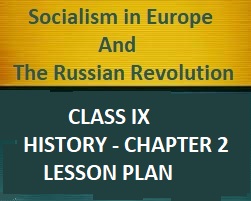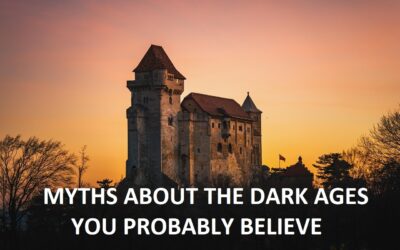Socialism in Europe and the Russian Revolution Lesson plan
Russian Revolution Lesson Plan mainly discusses the emergence of socialism as a political ideology and the events leading up to the Russian Revolution of 1917. It deals with the second chapter of Class 9 NCERT History textbook, “Socialism in Europe and the Russian Revolution,” The Russian Revolution Lesson Plan explores how socialism emerged as a response to the social, economic, and political changes brought about by the Industrial Revolution in Europe. It explains the various forms of socialism, including Utopian socialism, Marxist socialism, and Fabian socialism. This Russian Revolution Lesson Plan also covers the key events of the Revolution, including the February and October Revolutions and the establishment of the Soviet Union. So, let’s begin.
Socialism in Europe and the Russian Revolution Lesson plan
Class IX Chapter 2 Topic: Socialism in Europe and the Russian Revolution No. of periods required: 8-10
General Objective:
To develop interest in the subject. To develop the spirit of Nationalism among the students.
Specific Objective:
The main objective of teaching Socialism in Europe and the Russian Revolution to students is to help them develop a broader and more nuanced understanding of history, society, and culture, as they engage with one of the most transformative periods in human history. The main objective of teaching Socialism in Europe and the Russian Revolution to students is to
- understand the historical context, causes, and consequences of the emergence of socialism as a political ideology and the events leading up to the Russian Revolution.
- understand different forms of socialism and their impact on society, economy, and politics.
- learn about the causes of the Russian Revolution.
- know about the social, economic, and political factors that led to the overthrow of the Tsarist regime and the establishment of the Soviet Union.
- to understand the complexities of historical events and their relevance to contemporary society.
Learning Objective:
The learning objectives of teaching the French Revolution may vary depending on the level of the students, the curriculum, and the goals of the course. However, here are a few possible learning objectives that are included in a lesson plan:
- Understand the historical context
- Analyze the causes and consequences
- Identify the major events and figures
- Understand the impact of the Russian Revolution
- Develop critical thinking skills
Socialism in Europe and the Russian Revolution Lesson plan
Teaching Points:
- Introduction
- Industrial society and social change
- The coming of Socialism to Europe
- Support for Socialism
- The Russian Revolution
- Economy and Society
- Socialism in Russia
- A Turbulent Time: The 1905 Revolution
- The First World War and the Russian Empire
- The February Revolution
- The October Revolution and Changes
Teaching Aid
Textbook PPT and Smart Class
Teaching Methodology:
The teacher begins the class by Introducing the topic of socialism in Europe to the students.
The following methods will be adopted during the course of teaching. Here are some possible steps taken by the teacher:
Day 1: Brief overview of the industrial revolution
Firstly, the teacher will start with a brief overview of the industrial revolution and the impact it had on society. Explain how the growth of industry and urbanization led to new social and economic problems, such as exploitation of workers and widening wealth gaps.
Day 2: Introducing the concept of socialism
Secondly, the teacher will Introduce the concept of socialism as a response to these problems. Explain that socialism is an economic and political system that advocates for collective ownership of the means of production and distribution of goods and services, with the aim of creating a more equitable society.
Day 3 Historical context for socialism in Europe
Thirdly, the teacher provides some historical context for socialism in Europe. Discussing the growth of labor movements, trade unions, and socialist political parties in the late 19th and early 20th centuries. Will also mention some of the key socialist thinkers of the time, such as Karl Marx and Friedrich Engels.
Day 4: Introduce the Russian Revolution
Fourthly, Introduce the Russian Revolution as a pivotal moment in the history of socialism. Explains how the revolution was sparked by a combination of political, economic, and social factors. This will include the failure of the Russian monarchy, the impact of World War I, and the growing discontent of the working class.
Day 5: February Revolution & the October Revolution
Lastly, the teacher discusses the key events of the Russian Revolution. This will include the February Revolution, the October Revolution, and the establishment of the Soviet Union. While explaining the chapter, the teacher will also touch on some of the key figures of the revolution, such as Vladimir Lenin and Leon Trotsky.
Day 6: Legacy of Socialism in Europe
Finally, the teacher encourages students to think critically about the legacy of socialism in Europe and the world. Ask them to consider the successes and failures of socialist movements and governments. Also, reflect on the ongoing debates about the role of the state, the market, and individual rights in shaping society.
Socialism in Europe and the Russian Revolution Lesson plan
Activities Planned: Russian Revolution Lesson plan
Here are two classroom activities that will be conducted by the teacher during the course of teaching.
Topic: Socialism in Europe and the Russian Revolution
1. Debate activity:
Topic: Socialism in Europe and the Russian Revolution
The teacher divides the class into two groups.
Each group will be assigned a position to defend.
One group can argue in favor of socialism as a solution to the problems of industrialization and capitalism, while the other can argue against it.
Each group will research and prepare their arguments, and then present them in a formal debate format.
This activity will encourage students to think critically about the pros and cons of socialism.
Moreover, it will also develop their persuasive speaking and listening skills.
2. Simulation activity:
The teacher will divide the class in groups to simulate the Russian Revolution.
Each group will be given a topic like Bolsheviks, the Mensheviks, the Provisional Government, the workers, and the peasants.
Each group can represent a different faction.
The simulation can be structured as a role-play activity.
Here, students have to negotiate with each other, make decisions, and take actions that reflect the historical context of the revolution.
This activity will help students to understand the complexities of the revolution and the challenges faced by different groups with competing interests.
The activity will also promote teamwork, leadership, and problem-solving skills.
Classwork:
- Students will be asked to create a timeline of the major events leading up to the Russian Revolution of 1917.
This will include the growth of socialist ideas in Europe and the impact of World War I. 2. Students will be asked to Analyze primary source documents such as speeches and propaganda posters. This will help them to understand how socialist and communist parties communicated their message to the masses. 3. The teacher also plans to show a historical film or documentary on the Russian Revolution. Students will be asked to write a review analyzing how accurately the events were portrayed.
Homework
- Write a comparative essay on the similarities and differences between the Russian Revolution and the French Revolution of 1789.
- Create a map of Europe in the early 20th century, highlighting the major socialist and communist parties and their respective policies.
- Research the role of women in the socialist and communist movements, and analyze how their participation contributed to the broader struggle for gender equality.
Interdisciplinary learning: Russian Revolution Lesson plan
Interdisciplinary learning can help students to make connections between different subjects and to see the relevance of what they are learning to the world around them. Here are some interdisciplinary learning ideas that can be linked to the NCERT chapter on “Socialism in Europe and the Russian Revolution” for students in class 9:
History and Geography
Students can create a map of Europe in the early 20th century, highlighting the major socialist and communist parties and their respective policies. This activity can help students understand how geography influenced the spread of socialist ideas in Europe.
English Language Arts
Students can read and analyze works of literature, such as George Orwell’s “Animal Farm” or Maxim Gorky’s “Mother,” which explore themes of socialism and revolution. This activity can help students develop their critical reading and analytical skills.
Science:
Students can research the impact of industrialization on workers’ health and safety. They will also explore how socialist movements have advocated for better working conditions. This activity can help students understand the connection between scientific progress and social progress.
Remedial Measures:
In class 9, students who are struggling with the NCERT chapter on “Socialism in Europe and the Russian Revolution,” here the teacher plans two remedial measures that may be helpful to the slow learners
Use multimedia resources
Slow learners may benefit from using multimedia resources. This includes videos, podcasts, and interactive websites, to reinforce the concepts and ideas covered in the chapter. The teacher will use appropriate multimedia resources or create their own to help slow learners better grasp the content.
Provide additional support and guidance
The teachers will offer one-on-one tutoring or small group instruction to provide personalized attention. This will further help students work through difficult concepts. Teacher will also provide additional worksheets or supplementary materials to reinforce learning and build confidence.
Learning Outcome:
After reading the NCERT chapter “Socialism in Europe and the Russian Revolution,” students will be able to:
- explain the key concepts and theories of socialism and communism, including the role of capitalism, the importance of class struggle, and the vision of a classless society.
- describe the historical events and social conditions that led to the growth of socialist and communist movements in Europe.
- describe the events and key figures of the Russian Revolution of 1917, and analyze its impact on world history.
- evaluate the strengths and weaknesses of different political and economic systems, including socialism, capitalism, and communism. They should be able to analyze how these systems have affected people’s lives and shaped the course of history.
- Communicate their ideas and insights effectively, both orally and in writing.
Socialism in Europe and the Russian Revolution Lesson plan
Conclusion:
In conclusion, we hope that this Russian Revolution lesson plan will provide students with a deeper understanding of the social, economic, and political forces that have shaped the world we live in today. We believe that through this Russian Revolution lesson plan, students will easily explore the complex social, economic, and political conditions that led to the revolution, as well as the key figures and ideologies that shaped its course. By using this lesson plan on Russian Revolution, students will develop a better understanding of the subject. They can also contribute to the creation of a more just and equitable society. For History Chapter 1 The French Revolution Lesson Plan, click on the link. Please write your feedback on Russian Revolution lesson plan. It will help us to serve you better. You may be interested in Class IX NCERT History Chapter 1 The French Revolution Worksheet CBSE Class 9 Geography India – Size and Location Worksheet For Group Activity





0 Comments